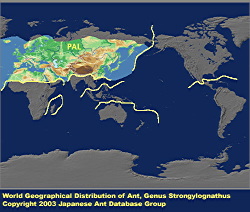
|
genus
|
Strongylognathus
|
 |
Japanese Name
|
Ibari-ari-zoku
|
Original Reference
|
|
Mayr, G. (1853) Ueber die Abtheilung der Myrmiciden, und eine neue Gattung derselben. Verhandlungen des Zoologisch-Botanischen Vereins in Wien 3: 387-394.
|
Description
|
|
Total length of workers around 2.5 - 4 mm. Body color yellow to yellowish brown. Mandibles falcate, each with an acute apical tooth; masticatory margins usually edentate, rarely with minute denticles on the apical portion. Antennae 12-segmented, the apical 3 segments forming a club. Palpal formula 4:3. Dorsal outline of mesosoma almost horizontal in profile. Propodeal teeth usually present.
|
|

|
Remarks
|
|
Strongylognathus comprises 24 named species distributed in the Palaearctic region (Pisarski, 1966; Baroni Urbani, 1969; Bolton 1976; Radchenko, 1985). The genus is divided into two species-groups, those of S. testaceus and S. huberi. Strongylognathus is similar to Tetramorium Mayr, but easily distinguished by its falcate mandibles, which resemble those of the slave-making formicine genus Polyergus Latreille. All Strongylognathus species are social parasites of Tetramorium caespitum (Linnaeus), T. jacoti Wheeler, and others. The parasitism varies in character from slave-making to permanent social parasitism. In the slave-making species workers do not forage outside the nest or care for larvae - these tasks are performed by workers of the host species. S. testaceus (Schenck) is an almost permanent social parasite. The female invades a host nest and does not kill the host queen, but afterwards lives within the host colony. S. koreanus Pisarski is the only known Japanese Strongylognathus species.
|
References
|
|
- Pisarski, B. (1966). Etudes sur les fourmis du genre Strongylognathus Mayr (Hymenoptera, Formicidae). . Ann. Zool. Warszawa, 23, 509-523.
- Baroni-Urbani, C. (1969). Gli Strongylognathus del gruppo huberi nell'Europa occidentale: saggio di una revisione basata sulla casta operaia (Hymenoptera Formicidae). . Boll. Soc. Ent. Ital., 99-101, 132-168.
- Bolton, B. (1976). The ant tribe Tetramoriini (Hymenoptera: Formicidae). Constituent genera, review of smller genera and revision of Triglypothrix Forel. . Bull. Br. Mus. Nat. Hist. (Ent.), 34, 281-378.
- Radchenko, A. G. (1985). Ants of the genus Strongylognathus (Hymenoptera, Formicidae) in the European part of the USSR. . Zool. Zhur., 64, 1514-1523. .
- Ueber die Abtheilung der Myrmiciden, und eine neue Gattung derselben. Verhandlungen des Zoologisch-Botanischen Vereins in Wien 3: 387-394.
|
Editor
|
|
Original text by Mamoru Terayama. English translation by Mamoru Terayama, edited by Robert W. Taylor.
|
|